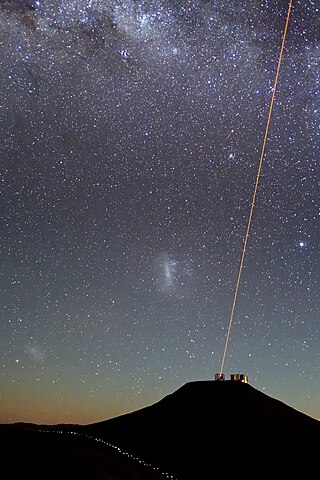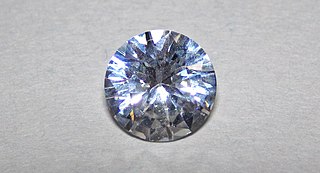
The active laser medium is the source of optical gain within a laser. The gain results from the stimulated emission of photons through electronic or molecular transitions to a lower energy state from a higher energy state previously populated by a pump source.

An optical amplifier is a device that amplifies an optical signal directly, without the need to first convert it to an electrical signal. An optical amplifier may be thought of as a laser without an optical cavity, or one in which feedback from the cavity is suppressed. Optical amplifiers are important in optical communication and laser physics. They are used as optical repeaters in the long distance fiber-optic cables which carry much of the world's telecommunication links.

A laser diode is a semiconductor device similar to a light-emitting diode in which a diode pumped directly with electrical current can create lasing conditions at the diode's junction.

Yttrium aluminium garnet (YAG, Y3Al5O12) is a synthetic crystalline material of the garnet group. It is a cubic yttrium aluminium oxide phase, with other examples being YAlO3 (YAP) in a hexagonal or an orthorhombic, perovskite-like form, and the monoclinic Y4Al2O9 (YAM).
Amplified spontaneous emission (ASE) or superluminescence is light, produced by spontaneous emission, that has been optically amplified by the process of stimulated emission in a gain medium. It is inherent in the field of random lasers.

Double-clad fiber (DCF) is a class of optical fiber with a structure consisting of three layers of optical material instead of the usual two. The inner-most layer is called the core. It is surrounded by the inner cladding, which is surrounded by the outer cladding. The three layers are made of materials with different refractive indices.
A fiber laser is a laser in which the active gain medium is an optical fiber doped with rare-earth elements such as erbium, ytterbium, neodymium, dysprosium, praseodymium, thulium and holmium. They are related to doped fiber amplifiers, which provide light amplification without lasing.

Coherent addition of lasers is a method of power scaling. It allows increasing the output power and brightness of single-transversal mode laser.
Filling factor, is a quantity measuring the efficiency of absorption of pump in the core of a double-clad fiber.
The Institute for Laser Science is a department of the University of Electro Communications, located near Tokyo, Japan.
Power scaling of a laser is increasing its output power without changing the geometry, shape, or principle of operation. Power scalability is considered an important advantage in a laser design. This means it can increase power without changing outside features.
Self-pulsation is a transient phenomenon in continuous-wave lasers. Self-pulsation takes place at the beginning of laser action. As the pump is switched on, the gain in the active medium rises and exceeds the steady-state value. The number of photons in the cavity increases, depleting the gain below the steady-state value, and so on. The laser pulsates; the output power at the peaks can be orders of magnitude larger than that between pulses. After several strong peaks, the amplitude of pulsation reduces, and the system behaves as a linear oscillator with damping. Then the pulsation decays; this is the beginning of the continuous-wave operation.
Round-trip gain refers to the laser physics, and laser cavities. It is gain, integrated along a ray, which makes a round-trip in the cavity.
A Talbot cavity is an external cavity used for the coherent beam combination of output from laser sets. It has been used experimentally for semiconductor laser diodes, carbon dioxide lasers, fiber lasers and solid-state disk lasers arranged in an array. In the simplest version, it is constructed with a single mirror at half the Talbot distance from the output facet of the laser array:
The McCumber relation is a relationship between the effective cross-sections of absorption and emission of light in the physics of solid-state lasers. It is named after Dean McCumber, who proposed the relationship in 1964.

Francisco Javier "Frank" Duarte is a laser physicist and author/editor of several books on tunable lasers.
In optical physics, laser detuning is the tuning of a laser to a frequency that is slightly off from a quantum system's resonant frequency. When used as a noun, the laser detuning is the difference between the resonance frequency of the system and the laser's optical frequency. Lasers tuned to a frequency below the resonant frequency are called red-detuned, and lasers tuned above resonance are called blue-detuned.
A nanophotonic resonator or nanocavity is an optical cavity which is on the order of tens to hundreds of nanometers in size. Optical cavities are a major component of all lasers, they are responsible for providing amplification of a light source via positive feedback, a process known as amplified spontaneous emission or ASE. Nanophotonic resonators offer inherently higher light energy confinement than ordinary cavities, which means stronger light-material interactions, and therefore lower lasing threshold provided the quality factor of the resonator is high. Nanophotonic resonators can be made with photonic crystals, silicon, diamond, or metals such as gold.

Nano-FTIR is a scanning probe technique that utilizes as a combination of two techniques: Fourier transform infrared spectroscopy (FTIR) and scattering-type scanning near-field optical microscopy (s-SNOM). As s-SNOM, nano-FTIR is based on atomic-force microscopy (AFM), where a sharp tip is illuminated by an external light source and the tip-scattered light is detected as a function of tip position. A typical nano-FTIR setup thus consists of an atomic force microscope, a broadband infrared light source used for tip illumination, and a Michelson interferometer acting as Fourier-transform spectrometer. In nano-FTIR, the sample stage is placed in one of the interferometer arms, which allows for recording both amplitude and phase of the detected light. Scanning the tip allows for performing hyperspectral imaging with nanoscale spatial resolution determined by the tip apex size. The use of broadband infrared sources enables the acquisition of continuous spectra, which is a distinctive feature of nano-FTIR compared to s-SNOM. Nano-FTIR is capable of performing infrared (IR) spectroscopy of materials in ultrasmall quantities and with nanoscale spatial resolution. The detection of a single molecular complex and the sensitivity to a single monolayer has been shown. Recording infrared spectra as a function of position can be used for nanoscale mapping of the sample chemical composition, performing a local ultrafast IR spectroscopy and analyzing the nanoscale intermolecular coupling, among others. A spatial resolution of 10 nm to 20 nm is routinely achieved.
Alexey Okulov is a Soviet and Russian physicist, the author of pioneering works in laser physics and theoretical physics.







































